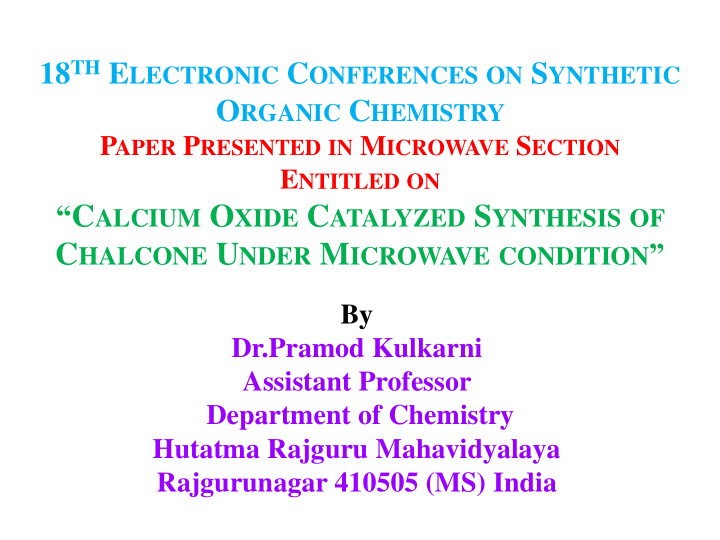



18 TH E LECTRONIC C ONFERENCES ON S YNTHETIC O RGANIC C HEMISTRY P APER P RESENTED IN M ICROWAVE S ECTION E NTITLED ON “ C ALCIUM O XIDE C ATALYZED S YNTHESIS OF C HALCONE U NDER M ICROWAVE CONDITION ” By Dr.Pramod Kulkarni Assistant Professor Department of Chemistry Hutatma Rajguru Mahavidyalaya Rajgurunagar 410505 (MS) India
M ERITS OF M ICROWAVE R EACTION Short Reaction time Easy workup procedure No side product Solvent free reaction condition High yield
C OMPARISON BETWEEN M ICROWAVE R EACTION AND T RADITIONAL M ETHODS Microwave Reaction Traditional Methods Particular reaction take Unwanted reaction take place place No side product formed Side products formed Short reaction time Long reaction time Isolation of product is easy Isolation of product is tedious process , require lot Solvent free, High yield of solvent for extraction Solvent is required and some times yield is low
C HALCONES
B IOLOGICAL I MPORTANCE OF C HALCONES Chalcones shows following important biological property 1. Antimalarials 2. Anti AIDS 3. Anti viral 4. Anti-inflammatory 5. Anticancer 6. Antibacteral 7.Antituberculosis 8. Antioxidants 9. Antileishmanials
C HALCONES AS S YNTHON FOR B IOACTIVE M OLECULES Synthesis of Flavonoids Synthesis of Bioactive Chalcone many Heterocyclic pharmaceuticals Five and Six member cyclic ring
M ETHODS FOR S YNTHESIS OF C HALCONES Chalcones are synthesised by following methods 1. Acid or Base catalyzed Clasien Schmidt condensation reaction 2. BF 3 . OEt 2 3. Suzuki coupling 4. Juliae Kocienski olefination
A CID OR B ASE CATALYZED C LASIEN S CHMIDT CONDENSATION REACTION Following different acids or bases are used Acids used are AlCl 3 , dry HCl, Zn(bpy)(OAC) 2 , TiCl 4 , Cp 2 ZrH 2 /NiCl 2 , and RuCl 3 Bases used are NaOH, KOH, LiOH, Ca(OH) 2 , Ba(OH) 2 , Magnesium t-butoxide, Potassium carbonate , Alumina, MgO, Calcinated hydrotalcites, KF/natural phosphate These methods suffer from drawbacks like expensive catalyst, drastic reaction condition, longer reaction time, low yield Hence there is scope to develop new methods in which these demerits are removed.
C ALCIUM O XIDE AS A GREEN S OLID B ASE C ATALYST Calcium oxide is green solid base catalyst due to following reasons 1. Calcium oxide is a white crystalline solid with a melting point of 2572 ° C 2. It is also uses to control pollution from power plants and remove phosphates from sewage 3. Calcium oxide is found in soil and it does not show any toxic effect as well as its occurrence in nature not affect on environment, stable at high temperature and water stable, no flammable, explosive or oxidizing properties
R ESULT AND D ISCUSSION First, we studied Claisen-Schmidt condensation reaction between benzaldehyde and acetophenone in the presence of calcium oxide as solid support. Benzaldehyde and acetophenone was dissolved in ethanol was added on calcium oxide to adsorbed after evaporating ethanol and we got free flowing powder. The resulting powder was exposed to microwave irradiation at 400W at power level 2 and progress of the reaction was monitored by TLC using (2:8) ethyl acetate and pet ether for an interval of 1minute and after 4 minute we observed that reaction proceed in the forward direction and formation of a new product.
• To indentify the structure of new product, after completion of reaction we workup the reaction mixture by adding 20mL ice cold water and neutralization with Conc. HCl, solid was precipitated. Solid was filtered on suction pump and wash with 20mL water, afforded crude product. • The crude product purified by recrystallization from ethanol afforded pure product. The structure of the pure product was confirmed by spectroscopic method and spectral data match with chalcone. • Next we decided to optimize reaction condition; we vary the amount of calcium oxide 10, 20, 40 mol% , 1:1 and 1:2 catalyst. It was found that 1:1 catalyst showed a maximum yield in short time interval. There was no reaction when condensation was carried out without calcium oxide which indicates that catalyst is necessary for the condensation reaction even under microwave conditions.
Figure 2 Synthesis of Chalcone under microwave condition using Calcium oxide as a catalyst • We synthesized different 15 chalcones with electron donating as well as electron withdrawing group both on ketone and aldehyde • Yield in the rang between 57-88 % • As usual electron withdrawing groups present on aldehyde and ketone proceeds very smoothly to afford chalcone in good yield; while substituent present on ortho-position gave a moderate yield due to steric effect.
C ONCLUSION Here, in this study we report facile, solvent free ecofriendly synthesis of chalcone under microwave condition. The merits of this method is avoid use of solvent, inexpensive and easily available catalyst, method is applicable to base sensitive functional group, easy work up and purification procedure, high yield short reaction time.
T HANK Y OU
Recommend
More recommend